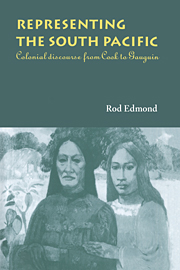Book contents
- Frontmatter
- Contents
- List of illustrations
- Acknowledgements
- 1 Introduction
- 2 Killing the god: the afterlife of Cook's death
- 3 Mutineers and beachcombers
- 4 Missionary endeavours
- 5 Trade and adventure
- 6 Taking up with kanakas: Robert Louis Stevenson and the Pacific
- 7 Skin and bones: Jack London's diseased Pacific
- 8 The French Pacific
- 9 Epilogue
- Notes
- Index
1 - Introduction
Published online by Cambridge University Press: 31 October 2009
- Frontmatter
- Contents
- List of illustrations
- Acknowledgements
- 1 Introduction
- 2 Killing the god: the afterlife of Cook's death
- 3 Mutineers and beachcombers
- 4 Missionary endeavours
- 5 Trade and adventure
- 6 Taking up with kanakas: Robert Louis Stevenson and the Pacific
- 7 Skin and bones: Jack London's diseased Pacific
- 8 The French Pacific
- 9 Epilogue
- Notes
- Index
Summary
‘it is half the planet: this half-globe,
this bulging
Eyeball of water, arched over to Asia,
Australia and white Antarctica: those are the eyelids that
never close; this is the staring unsleeping
Eye of the earth’
(Robinson Jeffers, ‘The Eye’)The most banal yet awesome fact about the pacific is its size. This vast ocean with its scattered pinprick islands has raised questions of scale, proportion and relation whenever it has been contemplated. From an outside perspective the islands of Oceania are almost submerged in the immensity of their surroundings (indeed Pacific islands have come and gone), their sea-locked inhabitants marooned on coral or volcanic tips of land. The Pacific, as opposed to its rim, is conceived as being more or less empty, the hole in the doughnut.
The inside perspective must always have been different. It is unlikely that Pacific peoples ever thought of themselves as inhabiting somewhere small, or that the disproportions of scale so striking to outsiders would have impressed them in the same way. In 1769 Tupaia, a priest from the Tahitian group of islands, drew Cook a map of his world. Taking its centre at Tahiti, the map showed seventy-four islands scattered across a large oceanic area measuring about three thousand miles from east to west and a thousand miles from north to south. The islands were arranged in concentric circles based on sailing times from the map's centre rather than on linear distance.
- Type
- Chapter
- Information
- Representing the South PacificColonial Discourse from Cook to Gauguin, pp. 1 - 22Publisher: Cambridge University PressPrint publication year: 1997
- 1
- Cited by

